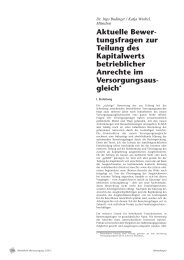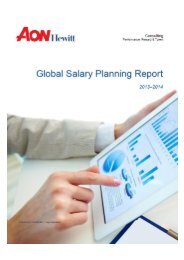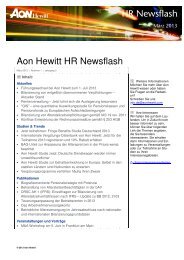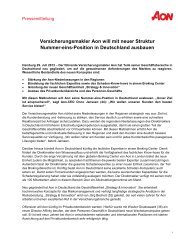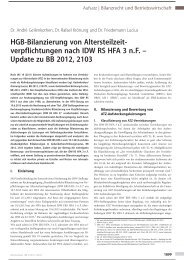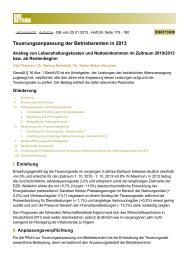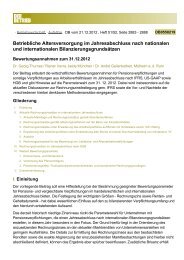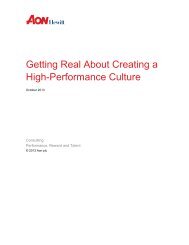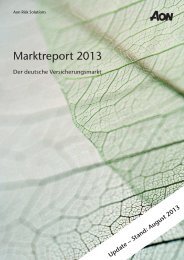09The Fac Report - Aon
09The Fac Report - Aon
09The Fac Report - Aon
Create successful ePaper yourself
Turn your PDF publications into a flip-book with our unique Google optimized e-Paper software.
09<br />
issue<br />
INSIDE THIS ISSUE<br />
A SEAMLESS PARTNERSHIP<br />
The combined power of facultative<br />
and treaty protections can deliver<br />
a valuable management tool for<br />
dealing with soft market conditions;<br />
Jeremy Goodman comments. 2<br />
A YEAR OF CHANGE<br />
2007 was marked by a number<br />
of significant transactions driven<br />
by market change. Benfield’s<br />
Research team reviews and analyses<br />
the hot developments of 2007. 2&3<br />
NEWS IN BRIEF<br />
A round up of recent developments<br />
for Benfield and for the <strong>Fac</strong>ultative<br />
Solutions team including new modelling<br />
capabilities, new services and new offices. 3<br />
SOFT MARKET SAVVY<br />
How insurers are looking to risk<br />
concentration modelling and analysis<br />
as a means of creating structures that<br />
better manage reinsurance costs and<br />
finding growth paths. 4<br />
CLARITY OF VISION<br />
Exposure management is a critical part<br />
of the underwriting equation. Benfield<br />
describes its latest moves to enhance<br />
underwriter access to expert systems. 5<br />
LAC TAKES OFF<br />
The current high levels of infrastructure<br />
development in Latin America and the<br />
Caribbean are prompting fresh demand<br />
for treaty and facultative protection. 6<br />
CARIBBEAN PROGRESS<br />
As the Caribbean Catastrophe Risk<br />
Insurance <strong>Fac</strong>ility gears up for its first<br />
renewal, Benfield reviews developments<br />
to date on this world first. 6<br />
BANKING MATTERS<br />
The current turmoil in financial markets<br />
may have turned sentiment against the<br />
banking sector, but for those prepared<br />
to differentiate some interesting<br />
opportunities may exist. 7<br />
WORLD VIEW<br />
Our regular ‘at a glance’ review<br />
of developments in regional markets<br />
worldwide and what these could<br />
mean during the next six months. 8<br />
Spring 2008<br />
The <strong>Fac</strong> <strong>Report</strong><br />
A Benfield Commentary on the <strong>Fac</strong>ultative Reinsurance Marketplace<br />
SHOCK LOSS THREAT THROWS<br />
SPOTLIGHT ON FAC<br />
Q1 rise in single risk losses prompts profit impairment fears<br />
A surge in large single risk losses during<br />
the first quarter of 2008 is focusing<br />
attention on the value of facultative<br />
reinsurance as a means of guarding<br />
against the negative impact on insurers’<br />
results from a series of ‘shock’ losses.<br />
Whilst fortuitous, rather than systemic<br />
in nature, the collective scale and frequency<br />
of the Q1 losses – which have been<br />
spread across a wide range of industries<br />
and geographical areas – are a cause<br />
of increasing concern in the insurance<br />
and reinsurance markets. As a result,<br />
there is growing speculation that the<br />
losses could start to stabilise primary<br />
rates, at least in specific occupancies<br />
or classes of business.<br />
Although no overriding pattern has<br />
emerged, a significant proportion of the<br />
losses have come from the mining, energy<br />
and steel sectors where, in a number<br />
of cases, the size of loss has been boosted<br />
by heavy business interruption and<br />
contingent business interruption claims<br />
fuelled by commodity prices. Largely<br />
driven by the huge appetite for primary<br />
resources, particularly from China,<br />
commodity prices are now also being<br />
pushed to new highs through the demand<br />
for ‘safe haven’ investments.<br />
The potential threat, which a string of<br />
large single losses could pose to an insurer’s<br />
www.benfieldgroup.com<br />
results, has been further exacerbated<br />
by the shift for underwriting operations<br />
to maintain higher treaty retentions.<br />
In addition, as treaty programmes pricing<br />
is designed to align relatively closely with<br />
a cedant’s underwriting results, insurers<br />
that experience a series of such losses<br />
could see an individualised impact in terms<br />
of future treaty costs. This in turn could<br />
impact competitive positioning and<br />
margins in an already tough market.<br />
Accordingly, various insurers are now<br />
considering facultative reinsurance both<br />
as a method of boosting sideways protection<br />
while avoiding the costly process of buying<br />
down retentions and of swiftly tailoring<br />
treaty programmes to reflect rapidly<br />
changing market dynamics. Perceived<br />
advantages of such a route also include<br />
the ability to maintain, or even grow,<br />
business levels in the affected classes<br />
if pricing, terms and conditions stabilise.<br />
In this context, facultative reinsurance<br />
also has applications for the captive sector<br />
where it offers a means of rebuilding<br />
attachment points at mid-term if a series<br />
of large single risk losses has exhausted<br />
captive or self insured retentions,<br />
so lowering insurers’ attachment points<br />
for the remainder of the policy term.<br />
erik.nikodem@benfieldgroup.com
COMMENT<br />
CREATING A SEAMLESS<br />
PARTNERSHIP<br />
In soft markets, when insurers and reinsurers are<br />
working hard to maintain underwriting discipline<br />
and profit potential, brokers that really add value<br />
are those that identify ways to boost customers’<br />
ultimate results through the intelligent use of<br />
reinsurance. Against this background, it is gratifying<br />
to note the soft market is serving as yet another<br />
example of how powerful facultative reinsurance<br />
can be as a strategic tool if used seamlessly<br />
with treaty programmes.<br />
For instance, having already proved its<br />
worth in hard markets, the combined capabilities<br />
of Benfield’s Dynamic Portfolio Optimisation<br />
and Cat<strong>Fac</strong> analysis are now being used to better<br />
identify ways in which to use combined treaty<br />
and facultative reinsurance to optimise the<br />
structure and cost of outwards programmes<br />
in a downwards spiral.<br />
Similarly, the sharp rise in large, single<br />
risk losses during the first quarter of 2008<br />
has underlined the applications of facultative<br />
reinsurance as sideways protection against shock<br />
losses within treaty retentions. Equally, facultative<br />
cover can also have a role to play in assisting<br />
treaty programmes to reflect changing market<br />
dynamics, one current example being the rise<br />
in potential business interruption costs due<br />
to record commodity prices.<br />
However, using facultative and treaty<br />
protections in this way can only really work<br />
if supported both by the necessary analytical tools<br />
to identify and analyse ‘hot spots’ and by brokers<br />
who have no hesitation about building close<br />
working partnerships which transcend traditional<br />
facultative and treaty boundaries. And all too<br />
often in practice such ‘one team’ thinking<br />
is impeded by both cultural and structural barriers<br />
such as geographical or business profit centres –<br />
hence the Benfield <strong>Fac</strong>ultative Solutions approach<br />
of having one global Profit & Loss.<br />
Simply put, if the broking sector is to ensure<br />
its customers are properly positioned to maximise<br />
capital efficiency during soft markets, while also<br />
establishing ‘shelf capacity’ that can be quickly<br />
used following an event-led turn in the market,<br />
it cannot allow the old attitudes to continue.<br />
Otherwise, it will be ignoring a potentially valuable<br />
tool in the sector’s drive to deliver highly tailored<br />
reinsurance strategies that meet the very individual<br />
needs of each and every carrier.<br />
jeremy.goodman@benfieldgroup.com<br />
Jeremy Goodman,<br />
Global Team Leader<br />
SOMETHING<br />
OLD AND<br />
SOMETHING<br />
NEW<br />
2007 was marked by a number of significant<br />
M&As ranging from SCOR’s acquisition<br />
of Converium to the moves both by recent<br />
start-ups and longer-established companies<br />
to take advantage of Lloyd’s to strengthen<br />
their business positions. There were also<br />
signs that the European Union Reinsurance<br />
Directive is acting as a stimulus for<br />
reorganisation in Europe. The Benfield<br />
Research team gives a brief overview.<br />
The acquisition of Converium by SCOR<br />
was perhaps the most important event in the<br />
reinsurance arena in 2007. SCOR took the<br />
market by surprise with its announcement<br />
of a 32.9% stake in Converium and its intention<br />
to launch a public tender offer for the<br />
remaining shares. After initially rejecting<br />
the approach, Converium’s Board of Directors<br />
subsequently recommended an improved offer<br />
to its shareholders. When the tender offer<br />
closed in July, SCOR had acceptances for over<br />
96% of Converium’s shares and the change<br />
of ownership was completed at the end<br />
of August. SCOR has subsequently raised<br />
its ownership to over 98%. The management<br />
of the combined entity moved swiftly<br />
to present clients with a unified approach<br />
at the September Rendez-vous in Monte-Carlo.<br />
Upgrades of the Lloyd’s financial strength<br />
rating to A+ by both Fitch and Standard<br />
& Poor’s, the acquisition of Equitas by Berkshire<br />
Hathaway’s National Indemnity and continued<br />
evidence of structural reform all contributed<br />
to the increasing attraction of Lloyd’s.<br />
For some newly established Bermuda players<br />
(and some not so new), Lloyd’s provides<br />
the obvious benefits of a higher rating, access<br />
to international licensing and distribution, and<br />
diversification of product line and geography.<br />
Deals during 2007 are shown in Figure 1.<br />
BENFIELD FACULTATIVE SOLUTIONS NEWSLETTER | SPRING 2008 | ISSUE 09 | PAGE 02<br />
Tokio Marine & Nichido Fire Insurance<br />
Company (TMNF), Japan’s oldest and largest<br />
non-life insurer, made a GBP442mn agreed<br />
offer for Kiln Ltd in December. The deal<br />
was completed on March 11 when Kiln joined<br />
Millea Group as a wholly-owned subsidiary<br />
of TMNF and was delisted from the London<br />
Stock Exchange. Kiln will play a pivotal role<br />
in the expansion of TMNF’s international<br />
underwriting operations and in enhancing<br />
its existing overseas activities.<br />
American Financial Group said its<br />
acquisition of a 67% stake in Marketform<br />
Group Limited “supports one of our strategic<br />
objectives of increasing AFG’s geographic<br />
coverage.” Munich Re’s acquisition of MSP<br />
Underwriting complements its existing Lloyd’s<br />
platform through Watkins. MSP owns Beaufort<br />
Underwriting Agency Limited (which manages<br />
Syndicate 318) and Evergreen Underwriting<br />
Services Limited.<br />
PARIS RE, now headquartered in<br />
Switzerland, emerged in its own right during<br />
2007. The company’s shares were listed on<br />
the Euronext Paris exchange in July. PARIS RE<br />
was awarded financial strength ratings of<br />
A- from both A.M. Best and Standard & Poor’s<br />
and began writing business from the end<br />
of September. The company operates in France,<br />
Switzerland, Bermuda, the USA, Canada,<br />
the UK and Singapore. Other young reinsurers<br />
which made Initial Public Offerings (IPOs) of<br />
their shares during 2007 are shown in Figure 2.<br />
The stream of new reinsurer formations<br />
slowed in 2007. The key arrivals are identified<br />
below.<br />
Ironshore Inc opened its doors to business<br />
at the start of the year. The company<br />
raised over USD1bn through a private<br />
placement of equity securities, with
a group of institutional investors including<br />
Bear Stearns, Lazard Alternative Investments<br />
and Fremont Partners. It commenced<br />
underwriting specialty lines of insurance<br />
immediately through its Bermuda based<br />
insurance subsidiary, Ironshore Insurance<br />
Ltd, which is rated A- by A.M. Best.<br />
The initial focus has been on US property<br />
catastrophe risks.<br />
Maiden Holdings Ltd was established<br />
in Bermuda. Capitalised at USD530mn,<br />
Maiden Insurance Company Ltd has an<br />
A- financial strength rating from A.M. Best.<br />
Maiden intends to write a portfolio of<br />
quota share and excess of loss reinsurance,<br />
targeting small insurance companies<br />
and managing general agents in the US<br />
and Europe. Initially it will take on business<br />
through a 40% quota share reinsurance<br />
treaty with AmTrust, a US-based multinational<br />
property and casualty insurer<br />
specialising in workers’ compensation<br />
insurance, extended warranty coverage,<br />
specialty property and casualty insurance<br />
and related products and services for<br />
small businesses.<br />
The implementation of the EU Reinsurance<br />
Directive from 1 January 2008 has provided<br />
the impetus for various corporate restructurings.<br />
Notable were Swiss Re and PartnerRe. Swiss<br />
Re has established Swiss Re Europe, SA, based<br />
in Luxembourg, which will serve as the risk<br />
carrier for most of the group’s European<br />
reinsurance and insurance business, operating<br />
via branches in the rest of the EU. The new<br />
legal structure is intended to improve the<br />
FIGURE 1 – LLOYD’S M&A IN 2007<br />
BENFIELD FACULTATIVE SOLUTIONS NEWSLETTER | SPRING 2008 | ISSUE 09 | PAGE 03<br />
alignment of regulatory and economic capital<br />
requirements. Swiss Re Europe will assume<br />
the life and non-life portfolios from the UK,<br />
Ireland, France, Germany, Spain, Italy, Denmark<br />
and The Netherlands. Business transfers started<br />
on 1 January and are expected to be complete<br />
by mid-2009.<br />
PartnerRe has renamed an existing<br />
Dublin-based subsidiary Partner Reinsurance<br />
Ireland Ltd. On 1 January 2008, this entity<br />
became the group’s risk carrier for business<br />
written out of France, Switzerland and<br />
Canada. As part of the transaction, the<br />
former French subsidiary, PartnerRe SA,<br />
was merged with PartnerRe Europe. Branch<br />
offices have been established in France<br />
and Switzerland.<br />
This article is an extract from ‘Changing<br />
the Game’, the 2008 edition of Benfield’s<br />
comprehensive review of trends and issues in<br />
the global reinsurance market. It provides<br />
a detailed commentary on the 2008 reinsurance<br />
renewals – including full regional and specialty<br />
market reviews – as well as discussion on key<br />
developments such as diversification, capital<br />
market appetite for reinsurance risk and<br />
reserving. A full copy of the article is available<br />
at www.benfieldgroup.com/research.<br />
The Benfield Research team publishes a<br />
wide range of independent research including<br />
quarterly reports on the Bermuda and<br />
European reinsurance markets. If you wish<br />
to subscribe to this free service please contact<br />
benfieldresearch@benfieldgroup.com.<br />
Date Acquirer Target Price GBPmn Syndicates<br />
May Validus Holdings Talbot Underwriting 194 1183<br />
July Ariel Re Atrium Underwriting 193 570, 609<br />
July Sagicor Gerling at Lloyd’s n.a. 1209<br />
October Munich Re MSP Underwriting 35–40 (est) 318<br />
December Tokio Marine & Nichido Fire Kiln Ltd 442 308, 510, 557, 807<br />
December American Financial Group Marketform 37 2468<br />
Source: Company announcements<br />
FIGURE 2 – 2007 IPOS<br />
Company Date Proceeds USDmn<br />
Validus January 345<br />
Flagstone March 173<br />
Greenlight May 258<br />
Source: Company announcements<br />
BENFIELD NEWS IN BRIEF<br />
BENFIELD PRELIMS<br />
In Benfield’s preliminary results for 2007,<br />
which were released on March 13, Benfield Chief<br />
Executive, Grahame Chilton, noted the group’s<br />
Global <strong>Fac</strong>ultative team performed well during<br />
the year, generating an improved margin and<br />
new business growth, particularly in energy and<br />
retrocession business and in the Latin American<br />
and European regions.<br />
REAL-TIME RATING CHANGE NOTIFICATIONS<br />
Benfield is the first reinsurance intermediary<br />
to notify US customers about reinsurer rating<br />
changes in real-time and correlate the impact<br />
to their specific reinsurance contracts. Utilising<br />
direct, live data from A.M. Best and leveraging<br />
the power of our proprietary Global Reinsurance<br />
Distribution System (GRiDS), Benfield delivers<br />
immediate notifications to those affected<br />
by reinsurer rating changes.<br />
CHINA DEVELOPMENTS<br />
Following approval from the China Insurance<br />
Regulatory Commission (CIRC), Benfield<br />
has opened a new representative office, Benfield<br />
Beijing, and upgraded the group’s Shanghai<br />
Representative Office to a General Representative<br />
Office. The moves further enhance Benfield’s<br />
commitment to the growing Chinese insurance<br />
market and the Greater China region.<br />
SINGLE RISK MODELLING SM<br />
Benfield is also the first reinsurance intermediary<br />
to bring US customers individual risk modelling<br />
results—the latest feature of our award-winning<br />
online risk mapping software, ExposureView.<br />
Underwriters and agents now have the ability<br />
to quickly obtain accurate, comprehensive modelled<br />
loss results for a single location policy before<br />
it is bound.<br />
LONG RANGE FORECASTS<br />
In its December 2007 extended range forecast<br />
for 2008 Atlantic hurricane activity, Benfieldsponsored<br />
Tropical Storm Risk (TSR) found early<br />
indications point to an active Atlantic hurricane<br />
season with Atlantic basin and US landfalling<br />
tropical cyclone activity being 50% above the<br />
1950-2007 norm. TSR calculated there is a high<br />
(~70%) likelihood that activity will be in the<br />
top one-third of years historically, forecasting<br />
15 Atlantic Basin tropical storms including eight<br />
hurricanes and four intense hurricanes.<br />
HURRICANE BREAKTHROUGH<br />
Ground breaking research from scientists at the<br />
Benfield UCL Hazard Research Centre (BUHRC),<br />
has for the first time quantified the link between<br />
sea surface warming and hurricane activity,<br />
which was published in scientific journal Nature.<br />
The paper found rising sea surface temperatures<br />
were responsible for about 40% of the increase<br />
in Atlantic hurricane activity between 1996 and<br />
2005 (when compared to a 50 year (1950-2000)<br />
average) and that the current sensitivity<br />
of hurricane activity to sea surface warming<br />
is large, with a 0.5°C rise being associated with<br />
an increase in activity of approximately 40%.
THE DPO DIFFERENCE<br />
Benfield’s Dynamic Portfolio Optimisation<br />
(DPO) is unique in that it addresses the correlation<br />
of risk through concentration. Accordingly,<br />
DPO-designed strategies quantify the impact on<br />
the entire PML curve, identifying the policies that<br />
have the most negative impact on results at the<br />
portfolio level. By contrast, other optimisation<br />
strategies tend to identify a portfolio’s ‘worst’<br />
policies on an individual basis without taking<br />
into account how those policies correlate<br />
to the remaining portfolio.<br />
As a result of this difference, DPO can assist<br />
underwriting entities to significantly enhance<br />
their strategic exposure management. Applications<br />
include identifying both the key risk drivers<br />
within property portfolios and areas that could<br />
be profitably written without a significant effect<br />
on PMLs. DPO also analyses the impact of potential<br />
changes to a portfolio in terms of what this<br />
would mean for reinsurance limits required,<br />
for the cost of reinsurance to be purchased and<br />
for the company’s retained net average annual loss.<br />
DPO IN BRIEF<br />
MODELS USED:<br />
RMS, AIR, or a blend of these models.<br />
PERILS:<br />
Hurricane and/or Earthquake.<br />
RISK APPETITE:<br />
Specific return time (e.g. 100-year) selected by<br />
the company.<br />
PROFITABILITY METRIC:<br />
Including or excluding non-catastrophe loss ratios.<br />
UNDERLYING REINSURANCE:<br />
Quota Share, Per Risk, <strong>Fac</strong>ultative and the Florida<br />
Hurricane Catastrophe Fund.<br />
KEY RISK DRIVER CANDIDATE RESTRICTIONS:<br />
Flexible identification of policies, e.g., personal<br />
lines policies only, avoiding profitable agencies,<br />
or excluding policies with supporting business, etc.<br />
GROWTH POLICY CANDIDATES:<br />
Prospective new portfolios, policies similar to the<br />
current portfolio, or standard sample policies.<br />
In addition to customising analysis parameters<br />
and policy selections, reports can be tailored<br />
to include detailed policy lists summarised<br />
by state, county, territory, or line of business,<br />
or can be profiled for underwriting purposes.<br />
Results can be shown as maps or used to<br />
generate impact scenarios for reinsurance cost.<br />
FINDING FRESH<br />
ANGLES IN<br />
SOFT MARKETS<br />
The need to optimise reinsurance structures<br />
and costs in a soft market is prompting<br />
insurers to use risk concentration modelling<br />
and analysis as a tool for businesses<br />
to identify growth opportunities within<br />
existing treaty structures.<br />
Examples of recent US projects have<br />
included analysing how books of construction<br />
risks could be rebalanced to provide a fresh<br />
approach for growth, and exploring potential<br />
strategies under which personal lines carriers<br />
– with multiple companies operating under<br />
different pricing structures – could grow the<br />
quality of their business by identifying where<br />
best to focus activity.<br />
Underpinning such initiatives has been<br />
the combined use of Dynamic Portfolio<br />
Optimisation (DPO) modelling, which looks<br />
at the concentration of risks within portfolios,<br />
and Cat<strong>Fac</strong> analysis. This duo creates the<br />
analytical groundwork from which to identify<br />
where growth can be achieved within existing<br />
PMLs. It can be accomplished by employing<br />
a dual strategy that focuses on underwriting<br />
of particular types of business while using<br />
facultative reinsurance to remove exposure<br />
‘hot spots’.<br />
This reflects the fact that the combined<br />
analytical process enables key exposure drivers<br />
first to be isolated, allowing very specific<br />
facultative reinsurance mechanisms to<br />
be structured to meet the particular needs<br />
of the portfolio. Given the tailored nature<br />
of facultative reinsurance, high levels of flexibility<br />
can be achieved using mechanisms ranging<br />
BENFIELD FACULTATIVE SOLUTIONS NEWSLETTER | SPRING 2008 | ISSUE 09 | PAGE 04<br />
from automatic, to pre-agreed rating<br />
agreements, to facilities.<br />
Other applications for DPO/Cat<strong>Fac</strong><br />
combined analysis include helping with<br />
the development of strategies for shared and<br />
layered business by understanding how best<br />
to build up portfolios through selective<br />
underwriting. In this context, facultative<br />
reinsurance acts as a tool to keep retentions<br />
on each layer within the predetermined plan.<br />
The DPO/Cat<strong>Fac</strong> methodology can also<br />
be used to better test assumptions in terms<br />
of the overall cost benefit of particular elements<br />
of their business when viewed in relation<br />
to wider capital considerations.<br />
The current interest in Benfield’s DPO/Cat<strong>Fac</strong><br />
capabilities is a testament to the flexibility<br />
of the tool, which first came to the forefront<br />
as a mechanism to tackle hard markets.<br />
In that scenario, the DPO/Cat<strong>Fac</strong> combination<br />
was used to identify the policies, and the<br />
locations within those policies, which were<br />
disproportionately driving PML curves<br />
for a given annualised event probability.<br />
The analysis was used to reinsure,<br />
on a facultative basis, such business<br />
on concurrent terms and conditions.<br />
Reflecting the potential value of such<br />
analysis, in one example, which was based<br />
on a portfolio’s 1:250 PML loss, some 5%<br />
of the portfolio’s multi location commercial<br />
property policies were found to be driving<br />
25% of the loss.<br />
sherry.thomas@us.benfieldgroup.com
CREATING A CLEARER PICTURE<br />
FOR UNDERWRITERS<br />
Following its success with US underwriters,<br />
Benfield has now started to roll out<br />
ExposureView, to a more international<br />
audience. As the first stage in this process,<br />
Benfield has established a London-based<br />
hub for the product which is working with<br />
a number of London Market companies<br />
on initiatives to enhance the depth of their<br />
US underwriting data.<br />
A market leading exposure management<br />
tool which uses geographic information systems<br />
to create a physical picture of risks and their<br />
accumulations, ExposureView has been in use<br />
by US insurers since 2003 as a key technology<br />
to visualise the potential impact of catastrophe<br />
events such as wind, terrorism or wildfire on<br />
their portfolios both during and after an event.<br />
Originally developed to provide US insurers<br />
with daily updates of wildfires, the system<br />
has now become a valued underwriting tool<br />
and can be used with a wide range of data<br />
including personal and commercial property,<br />
auto business, workers compensation risks<br />
and offshore platforms.<br />
Key to ExposureView’s success is that<br />
it not only enables underwriters to plot and<br />
view all individual risks – whether by street<br />
address or a specific latitude/longitude – but<br />
also overlays such information with ‘hazard<br />
shapes’ or polygons that outline the boundaries<br />
and impact of events.<br />
BENFIELD FACULTATIVE SOLUTIONS NEWSLETTER | SPRING 2008 | ISSUE 09 | PAGE 05<br />
Equally important, from an underwriting<br />
perspective, the system also enables insurers<br />
both to view specific risks and to see how<br />
potential new risks would fit with the overall<br />
balance and underwriting limitation of existing<br />
portfolios. For instance, where necessary,<br />
radius-based exclusion zones can be plotted<br />
in conjunction with specific risks, to ensure<br />
accumulation limitations are maintained, e.g.,<br />
when underwriting terrorism risks.<br />
The map-based output from the system<br />
has also been highly valuable to claims’ teams<br />
for use in deploying adjusters and managing<br />
and analysing claims.<br />
One of the key features of ExposureView,<br />
in addition to the system’s mapping capabilities,<br />
is the way in which it enables underwriters,<br />
at the touch of a button, to retrieve their data<br />
in spreadsheet format. This facility provides<br />
instant access to the necessary information<br />
to manage, analyse and evaluate claims,<br />
enabling underwriters to produce swift exposure<br />
evaluations in the wake of a major event.<br />
In order to maximise the value of this<br />
application, underwriters can, if required, take<br />
a highly selective approach to retrieving data,<br />
far beyond class of business. Examples include<br />
the ability to isolate information on beachfront<br />
properties or those that are of a wooden<br />
construction type. The system’s current library<br />
of information includes a wide range of data<br />
including maps of hurricane wind speeds from<br />
past events, footprints of past windstorm<br />
events, data on various US earthquake zones<br />
and also a terrorism target database. In addition,<br />
it can also be used to visualise the impact<br />
of Lloyd’s Realistic Disaster Scenarios.<br />
Whilst the system’s Benfield-sourced<br />
library of hazard shapes at present principally<br />
focuses on US exposures, the system has<br />
mapping availability for 63 countries. Given<br />
users can tailor the system by incorporating<br />
their own libraries of hazard shapes, this also<br />
means the system has applications as a base<br />
from which insurers can build highly tailored<br />
exposure modelling tools, which reflect<br />
the particular geographical priorities of their<br />
own businesses.<br />
All user information, including personal<br />
libraries of event information, is only accessible<br />
to the user in question, to maintain full<br />
confidentiality.<br />
dave.barthorpe@benfieldgroup.com<br />
paul.budde@benfieldgroup.com<br />
Readily accessible with a web browser and<br />
an internet connection, ExposureView is part<br />
of the value-added, innovative services<br />
and technology that Benfield provides<br />
to its customers. For further information,<br />
go to www.benfieldremetrics.com.<br />
Wilma 2005 wind<br />
speed forecasts
CARIBBEAN RENEWAL MOVE<br />
June sees the first renewal of the world’s first<br />
multi-country disaster insurance facility, the<br />
Caribbean Catastrophe Risk Insurance <strong>Fac</strong>ility<br />
(CCRIF) with several measures designed to further<br />
fill the liquidity gap for countries after a natural<br />
catastrophe.<br />
In a February bulletin, the CCRIF announced<br />
a 10% reduction in premiums charged to<br />
participating governments, a decrease in the<br />
minimum attachment point for hurricane policies<br />
from one in 20 year events to one in 15 year<br />
events, an increase in limits to USD100m per peril<br />
from USD50m and a minimum payment, when<br />
triggered, equivalent to the relevant country’s<br />
annual policy premium. The scheme, which<br />
in its first year made payments to Dominica and<br />
St Lucia in respect of the powerful earthquake<br />
which rocked the Caribbean at the end of<br />
November, also stated payment of legitimate<br />
claims will be accelerated to as little as 14 days.<br />
The CCRIF facility was structured in<br />
conjunction with Benfield, as sole adviser, using<br />
a mixture of aggregate catastrophe excess<br />
of loss layers and a catastrophe swap. As a result,<br />
the CCRIF also has the distinction of being<br />
the first insurance facility to develop a parametric<br />
insurance policy that is backed by both traditional<br />
reinsurance and capital markets.<br />
Just as important, it offers a fresh perspective<br />
on how governments can work with the commercial<br />
insurance and reinsurance sector. The scheme<br />
has overcome many of the issues which have<br />
historically hindered the development of such<br />
government-backed initiatives – including striking<br />
a workable balance between building capital and<br />
imposing compulsory contributions on individuals<br />
– by taking a far broader and more integrated<br />
intergovernmental approach.<br />
Critically the CCRIF provides participating<br />
governments, rather than individuals, with<br />
immediate liquidity if their countries are hit<br />
by a hurricane or earthquake.<br />
The CCRIF’s structure – which could be applied<br />
to anywhere from Central America to China<br />
to Africa – potentially points the way for future<br />
inter-government natural perils initiatives.<br />
Reflecting this, the World Bank, which provided<br />
support and seed capital for the project, has<br />
indicated it could serve as a pilot for similar<br />
initiatives in other regions with small states,<br />
such as the Pacific basin.<br />
david.simmons@benfieldgroup.com<br />
aidan.pope@benfieldgroup.com<br />
TAPPING INTO A GROWTH<br />
PROPOSITION<br />
Insurers are increasingly turning their<br />
attention to the possibilities offered<br />
by Latin America and the Caribbean (LAC)<br />
due to the current surge in infrastructure<br />
development fuelled, in large part,<br />
by revenues generated by the commodities<br />
boom.<br />
Such is the scale of current developments,<br />
that for the first time the combined value<br />
of the Top 50 strategic infrastructure projects<br />
in LAC, as selected by the Sixth Annual Latin<br />
American Leadership Forum which took place<br />
in early April, has exceeded USD50bn.<br />
The current focus on infrastructure<br />
development reflects a general acceptance<br />
that if LAC is to sustain and improve current<br />
growth rates, the region needs to invest<br />
significantly in all aspects of critical<br />
infrastructure ranging from greater power<br />
generation to better road links.<br />
Estimates published in August 2005<br />
in Infrastructure in Latin America and the<br />
Caribbean: Recent Developments and Key<br />
Challenges, a report by World Bank economists<br />
Marianne Fay and Mary Morrison, indicated<br />
spending would need to reach 4% to 6%<br />
of GDP a year – as opposed to less than 2%<br />
at that time – for infrastructure to catch<br />
up or keep up with countries that once trailed<br />
it, such as Korea and China. The report added<br />
that while infrastructure had improved in<br />
BENFIELD FACULTATIVE SOLUTIONS NEWSLETTER | SPRING 2008 | ISSUE 09 | PAGE 06<br />
most of LAC over the last decade, a sharp<br />
fall in investment in the sector was hindering<br />
economic growth, poverty reduction and<br />
the region’s ability to compete with China<br />
and other dynamic Asian economies. Using<br />
logistics costs (transportation and storage)<br />
as one example, it added that while these were<br />
about 10% of product value in industrialised<br />
countries, in LAC they ranged from 15%<br />
in Chile to 34% in Peru.<br />
Current projects range from the USD15bn<br />
plus oil and gas initiative featuring the USD5bn<br />
Camperj Petrochemical Complex in Rio<br />
de Janeiro and other strategic projects from<br />
Petrobras, Pemex and Petrojam through to<br />
USD3.2bn of ports and logistics developments<br />
featuring the Buenaventura port projects and<br />
including major highway and inter-modal<br />
logistics in Colombia. A number of projects<br />
in areas such as the Dominican Republic and<br />
Mexico are also looking at renewable energy<br />
generation through such technologies<br />
as bio-diesel, solar farms and wind farms.<br />
Against this background, demand for<br />
construction insurance is increasing significantly,<br />
as is demand for business interruption type<br />
covers including advance loss of profits – for<br />
instance, to protect against situations such<br />
as where a power station does not come<br />
on line as planned. In addition to the need for<br />
significant capacity, interest in the offerings<br />
of international markets is also being prompted<br />
by the desire to tap into the expertise of<br />
insurers versed in some of the state of the art<br />
technologies which are relatively new to LAC.<br />
Separately, the commodity boom has<br />
also created greater awareness of the value<br />
of insurance, partly because there have been<br />
a number of significant business interruption<br />
losses in the region affecting operations<br />
in various business sectors. Recent examples<br />
range from events impacting Brazil’s largest<br />
steelmaker, CSN and Sadia, one of the world’s<br />
leading producers of chilled and frozen<br />
foods through to Chile’s giant food producing<br />
company, Agrosuper.<br />
Given that up to 50% of ceded premium<br />
is being spent on facultative reinsurance,<br />
Latin America is being seen as a growth area<br />
for both facultative and treaty business.<br />
Reflecting this, Benfield is in the process<br />
of expanding its presence in the region<br />
and intends to open further offices in the<br />
near future.<br />
pablo.munoz@benfieldgroup.com
OPINION: SORTING THE<br />
WHEAT FROM THE CHAFF<br />
The ongoing turmoil in global financial<br />
markets may have created wide ranging<br />
uncertainty for a series of products including<br />
directors and officers (D&O), financial<br />
institutions, structured credit and financial<br />
guarantee business as well as certain types<br />
of errors and omissions (E&O) protections,<br />
but there is also a danger that it is blinding<br />
the insurance sector to potentially good<br />
business opportunities as well.<br />
At present, the one thing that is not in<br />
doubt is that there will be considerable activity<br />
on the legal front. Nor, on the basis of past<br />
experience, can it be assumed that the insurance<br />
world will be as insulated from such actions<br />
as might, at first glance, seem likely. Plaintiffs’<br />
attorneys will be mustering their resources<br />
to find ways through to potential ‘deep pockets’<br />
– a factor which raises the potential for<br />
creeping exposures on the D&O and E&O front,<br />
if only due to the need to defend against<br />
‘phantom’, as well as potential, liabilities.<br />
Separately, the long-term security of the<br />
monoline financial guarantee insurers is still<br />
under close scrutiny. In this respect it is perhaps<br />
salutary to reflect just how damaging to their<br />
core business of guaranteeing municipal<br />
bonds such insurers’ forays into guaranteeing<br />
other products, such as wraps of synthetic<br />
financial structures, have been. Simply put,<br />
it took the monolines 25 years to develop<br />
a 50% penetration of the US municipal bond<br />
markets in the US. Now, in just a few short<br />
months, that market share has contracted<br />
to some 20%.<br />
Against this background, it is important<br />
not to lose sight of the fact that a significant<br />
portion of the very large losses recently<br />
announced by financial institutions flows from<br />
recently instituted accounting regulations<br />
involving mark to market assessments, rather<br />
than losses crystallised from the sale of assets.<br />
Such is the extent of impact of these regulations<br />
that at least one large financial institution<br />
has questioned whether the regulations need<br />
amendment. Accordingly, until the mortgage<br />
issues in the US unwind, the full extent<br />
of institutions’ exposures and ultimate losses<br />
will be unclear.<br />
It is also important to bear in mind that<br />
the mortgage related issues have not impacted<br />
all industry and trade sectors to the same<br />
degree. Financial assessments suggest that<br />
many industries are continuing to perform<br />
in an acceptable manner, despite tighter<br />
controls on credit.<br />
BENFIELD FACULTATIVE SOLUTIONS NEWSLETTER | SPRING 2008 | ISSUE 09 | PAGE 07<br />
All of this means that, despite the current<br />
generally negative sentiment about the banking<br />
sector, financial institutions will continue<br />
to be a potential source of good quality risks,<br />
particularly in the trade credit, surety and<br />
political risk areas.<br />
Indeed, the very issue of banks’ reducing<br />
capital bases, combined with the requirements<br />
of Basle II, means many banks increasingly<br />
need to assess the best allocation of capital<br />
to maximise their returns – an area in which<br />
insurance can assist by reducing exposures<br />
to risks producing lower returns, so allowing<br />
banks to concentrate on those areas of<br />
businesses which produce the highest return<br />
on capital.<br />
As in all situations, it is important to<br />
differentiate between the varying types of risk<br />
that may originate from the banking sector<br />
and not to apply a rigid, and perhaps less than<br />
open view, to new opportunities. The insurance<br />
market is in a position to assist, and has the<br />
chance to grow its own portfolio whilst still<br />
maintaining a disciplined and conservative<br />
approach to the business.<br />
As ever, in problems also lie opportunities<br />
and it may just be that now is the time when<br />
those insurers that are prepared to look beyond<br />
sentiment to the actual risks in question may<br />
be pleasantly surprised by the flow of good<br />
quality risks coming to the market. It would<br />
be a shame if such an opportunity to make<br />
the most of a real underwriting opportunity<br />
were to be missed because perception was<br />
allowed to rule over reality.<br />
phil.bonner@benfieldgroup.com<br />
FACULTATIVE SOLUTIONS TEAM<br />
The <strong>Fac</strong>ultative Solutions team is part of the<br />
leading reinsurance and risk intermediary,<br />
Benfield, which is listed on the London Stock<br />
Exchange under the ticker symbol BFD.<br />
With a worldwide presence of experts from<br />
the property, casualty, financial lines and energy<br />
sectors, we operate as one team, regardless<br />
of international boundaries, with one profit centre,<br />
empowering every member with access to<br />
markets. Appropriately authorised Team Members<br />
in Benfield give us expertise in alternative capital<br />
solutions.<br />
Drawing on the Group’s actuarial and analytical<br />
skills, including Benfield’s market leading<br />
catastrophe modelling, dynamic financial analysis<br />
and dynamic portfolio optimisation capabilities,<br />
we use our own resources to structure and place<br />
optimum solutions for customers in all classes<br />
of reinsurance.<br />
Jeremy Goodman, Global Team Leader<br />
jeremy.goodman@us.benfieldgroup.com<br />
+1 917 320 4524<br />
EUROPE<br />
Michael Papworth, Team Leader London and<br />
Global Property & Specialty<br />
michael.papworth@benfieldgroup.com<br />
+44 (0)20 7522 3956<br />
Andrew Hopkins, Japan and AAA Team Leader, London<br />
andrew.hopkins@benfieldgroup.com<br />
+44 (0)20 7522 3902<br />
Pablo Muñoz, Latin American & Caribbean<br />
Team Leader, London<br />
pablo.munoz@benfieldgroup.com<br />
+44 (0)20 7712 8515<br />
Pierre Bruylants, Europe Team Leader, Brussels<br />
pierre.bruylants@benfieldgroup.com<br />
+32 2 709 21 91<br />
NORTH AMERICA/BERMUDA<br />
Erik Nikodem, North America/Bermuda<br />
Team Leader, Bermuda<br />
erik.nikodem@us.benfieldgroup.com<br />
+1 441 278 4544<br />
AUSTRALIA/NEW ZEALAND/SOUTH AFRICA<br />
Michael Lazarus, AAA Team Leader, Australia<br />
michael.lazarus@benfieldgroup.com<br />
+612 8209 4291<br />
SINGAPORE<br />
Nigel Cross, Singapore Team Leader, Singapore<br />
nigel.cross@benfieldgroup.com<br />
+65 6512 0211<br />
If you would like to register to receive The <strong>Fac</strong> <strong>Report</strong>,<br />
please contact us at thefacreport@benfieldgroup.com.<br />
© Benfield Group Limited 2008. Benfield has used due<br />
care in the preparation of this report. Our information<br />
has been obtained from sources we consider reliable,<br />
but its accuracy and/or completeness is not guaranteed.<br />
This report is made available on an “as-is” basis and<br />
Benfield will not accept liability to any person for the<br />
consequences of reliance placed on its content. Benfield<br />
reserves all rights to the contents of this document.
WORLD<br />
VIEW<br />
EUROPE<br />
Following a second year of low insured industrial and<br />
catastrophic loss activity, industrial property prices have<br />
continued to fall slowly with average rate reductions being<br />
seen across Europe of some 10% to 15% during the last<br />
renewal period.<br />
Insurers and reinsurers are continuing to post record<br />
profits on the back of significant reductions in the frequency<br />
and severity of losses driven by high deductibles and the<br />
success of risk management initiatives focusing on risk<br />
improvement and loss prevention.<br />
Reinsurance cost and reinsurer security remain top<br />
priorities for cedants, many of which are maintaining significant<br />
retentions, buying out volatility such as catastrophes, terrorism<br />
and high risk activities. The market is also seeing more<br />
and more multiyear deals as risk managers seek to secure<br />
guaranteed long-term capacity at today’s competitive rates.<br />
Speculation is now growing that if lower than expected<br />
2008 investment returns coincide with higher combined<br />
loss ratios, this could depress profits sufficiently to trigger<br />
a cycle change.<br />
pierre.bruylants@benfieldgroup.com<br />
LATIN AMERICA AND THE CARIBBEAN<br />
Demand for facultative covers continues to be strong, with<br />
no shortage of business flow, as cedants in Latin America<br />
and the Caribbean seek insurance and reinsurance solutions<br />
for their ever expanding business bases. The region’s many<br />
entrepreneurs are showing no hesitation about seeking<br />
international expertise as necessary. This appetite for facultative<br />
market solutions is being further supported by the<br />
general softening market conditions which mean plentiful<br />
capacity is available at very attractive prices which are<br />
still showing very good returns for both buyers and sellers.<br />
As expected, at the end of 2007 the Brazilian market<br />
was partially opened to external players. In essence, the move<br />
means that although cedants will still be obliged to offer<br />
60% of reinsurance placements to the local market, 40%<br />
can now be offered to the international markets. Although<br />
early days, the general expectation is that the liberalisation<br />
initiative will create a new, dynamic market place with<br />
multiple participants.<br />
pablo.munoz@benfieldgroup.com<br />
NORTH AMERICA AND CANADA<br />
Property insurance rates continue to deteriorate, particularly<br />
in the middle-market arena, where there is an increasingly<br />
large over supply of capacity. In particular, the excess and<br />
surplus lines sector in the US has become fiercely competitive<br />
due to a number of factors. These include both a significant<br />
growth in the distribution networks being used by existing<br />
players and the entry of various new underwriting entities<br />
to the sector which are seeking market share. Casualty<br />
rates, while deteriorating, are not falling as precipitously,<br />
partly due to a stabilisation of terms in various niche and<br />
professional lines.<br />
As underwriters seek additional limits to protect their<br />
renewal positions or achieve more significant participations<br />
BENFIELD FACULTATIVE SOLUTIONS NEWSLETTER | SPRING 2008 | ISSUE 09 | PAGE 08<br />
on new business accounts, the perceived value of property<br />
and casualty facultative capacity – and therefore demand<br />
– continues to grow. <strong>Fac</strong>ultative reinsurance also continues<br />
to be a valuable tool to those seeking to expand distribution,<br />
increase hit-ratios and retain more business irrespective<br />
of market conditions.<br />
erik.nikodem@benfieldgroup.com<br />
BERMUDA<br />
While the lack of significant property catastrophe or casualty<br />
events have contributed to a raft of, on the whole, record 2007<br />
profits for Bermuda’s reinsurers and insurers, such results<br />
have also been fundamentally predicated on the maintenance<br />
of good market discipline. Overall, the market’s underwriters<br />
have been taking a very consistent and prudent approach<br />
to the underwriting of risk and to ensuring rate and term<br />
adequacy in the softening cycle.<br />
That said, the fluidity of layering options, dynamic<br />
attachment points and the time-tested import of secure,<br />
stable capacity which is unencumbered by the legacy issues<br />
that are adversely affecting the balance-sheets of several<br />
underwriters, means 2008 still presents the prospect<br />
of attractive facultative partnership opportunities for both<br />
cedants and reinsurers. Accordingly, despite the overall<br />
softening in market conditions, the number and quality<br />
of mutually beneficial deals to be struck between buyers<br />
and sellers of facultative reinsurance continues to escalate.<br />
erik.nikodem@benfieldgroup.com<br />
ASIA<br />
Driven by strong underwriting results, over supply of primary<br />
and reinsurance capacity and strong competition among<br />
the major retail broking houses, the soft market for property<br />
and casualty risks has continued. Reflecting this, a number<br />
of large power, energy and high tech risks renewed during<br />
the first quarter of 2008 at significant premium reductions.<br />
While a few major engineering projects have been delayed<br />
due to financing issues, it still remains to be seen whether<br />
the global economic situation is likely to have a more profound<br />
effect on the region. Certainly, to date, investment in large<br />
infrastructure projects covering everything from utilities<br />
to refining has generally continued unchecked.<br />
Separately, while a slight increase in recent loss activity<br />
in the region has done little to stem the tide of softening<br />
underwriting market, sentiment is now growing that any<br />
further rises will force insurers and reinsurers to take a more<br />
defensive position in managing their portfolios and protecting<br />
their net positions.<br />
nigel.cross@benfieldgroup.com<br />
JAPAN<br />
The second half of 2007 and early 2008 saw several large fire<br />
losses in Japan and a large mining loss in Australia involving<br />
Japanese interests. However, apart from the Matsushita Battery<br />
loss, these so far appear to have mainly impacted insurers’<br />
net and treaty results, rather than affecting facultative<br />
reinsurers. Reinsurers also benefited from a benign 2007<br />
Japanese windstorm season and lack of facultative<br />
earthquake losses.<br />
Accordingly, the facultative market took a favourable<br />
view of Japanese business at the 1 April renewals, offering<br />
improvements in rating, capacity and flexibility for fire<br />
and natural catastrophe exposed business. There were also<br />
opportunities to structure specific facultative peak risk<br />
facilities, closely linked to treaty placements.<br />
The Matsushita Battery fire focused attention on BI and<br />
CBI exposures flowing from high levels of interdependency<br />
between manufacturers. The continuing trend for large<br />
investments in the flat screen and semiconductor sector has<br />
also prompted increased demand for facultative reinsurance<br />
to manage peak exposures and PMLs.<br />
andrew.hopkins@benfieldgroup.com<br />
AUSTRALIA AND NEW ZEALAND<br />
The first quarter of 2008 has proved very slow in the<br />
Australian and New Zealand markets, making it difficult<br />
to assess with any degree of confidence what the year<br />
may hold in store.<br />
Unusually high rain fall during January and February<br />
along the eastern seaboard of Australia resulted in a number<br />
of large flood related claims with the mining sector being<br />
particularly affected. Taken in conjunction with a large loss<br />
in Peru which falls into one of Australia’s largest mining<br />
schedules, this now means there is in excess of AUD1bn<br />
of losses emanating from the Australian mining account.<br />
While it is yet too early to say what impact this will have<br />
on the mining sector – and possibly even the wider property<br />
market – the developments have caused some concern<br />
in the market.<br />
Separately, fuelled by abundant capacity and competition,<br />
New Zealand continues on its soft market path with no end<br />
in sight to the current round of rate reductions.<br />
michael.lazarus@benfieldgroup.com<br />
SOUTH AFRICA<br />
Although 2007 was once again a profitable year for the<br />
local insurance industry, a deterioration in technical results<br />
means that both insurers and reinsurers are seeing a decrease<br />
in returns from the high levels of profitability achieved over<br />
recent years.<br />
At the same time, over supply of treaty capacity<br />
and aggressive retail broking activity, coupled with the lack<br />
of catastrophe losses both locally and internationally, continue<br />
to keep rating levels down. The abundance of treaty capacity<br />
has also reduced the demand among insurers for facultative<br />
alternatives.<br />
Looking ahead, there are now signs that local market<br />
conditions may be starting to change. The 2007 deterioration<br />
in technical results has been followed by a 2008 first quarter<br />
notable for the number of large claims which have occurred<br />
in the corporate sector. Accordingly, speculation is starting<br />
to build that such developments could trigger the necessary<br />
pressures for rates to level off in the medium term.<br />
john.goetzsche@benfieldgroup.com



